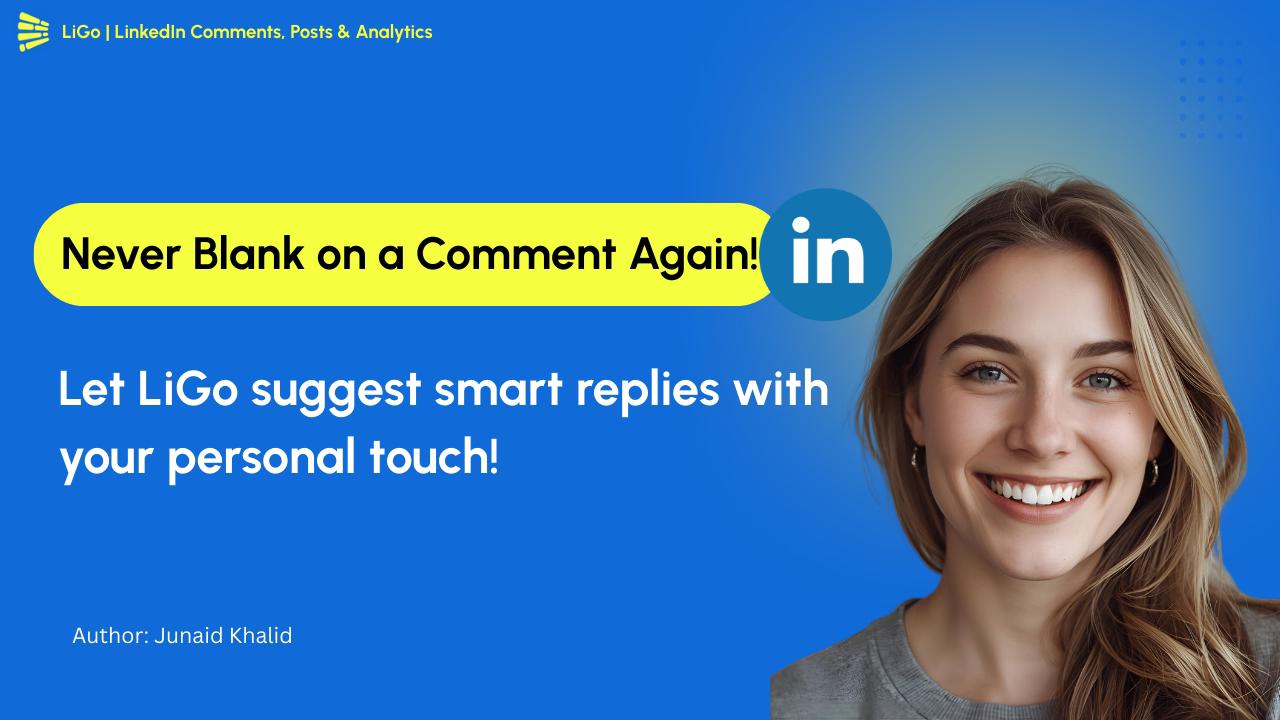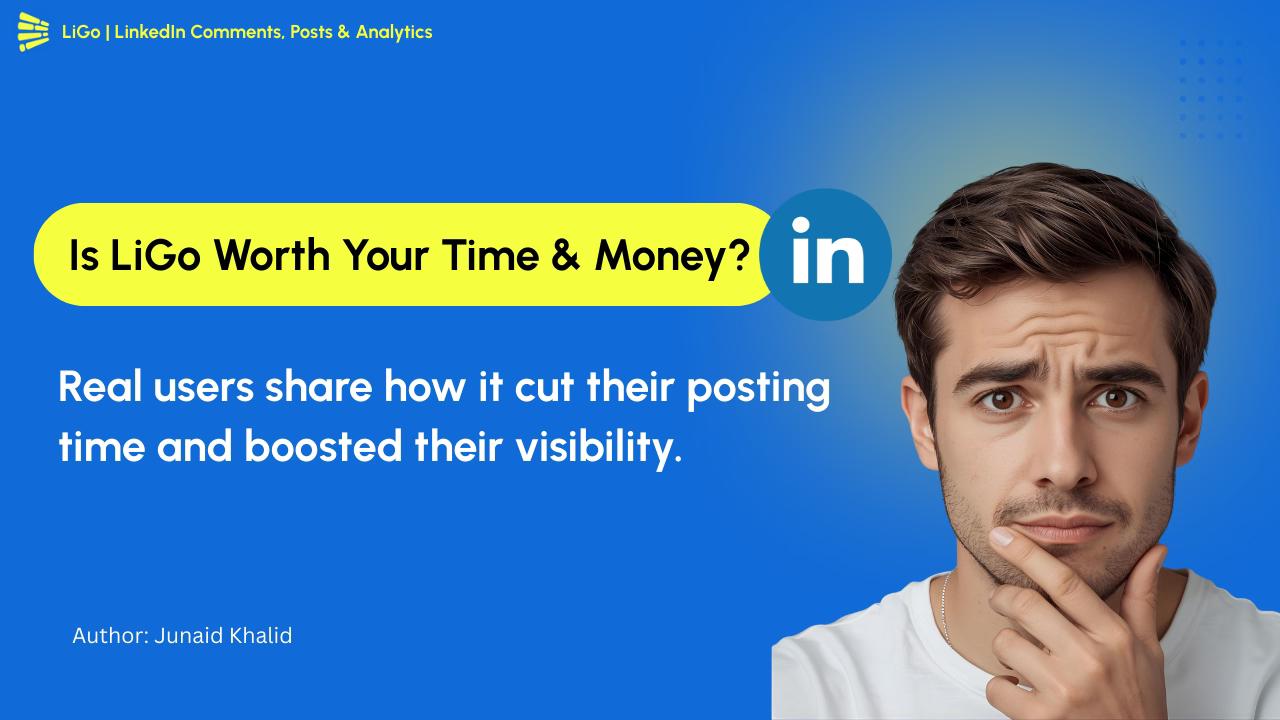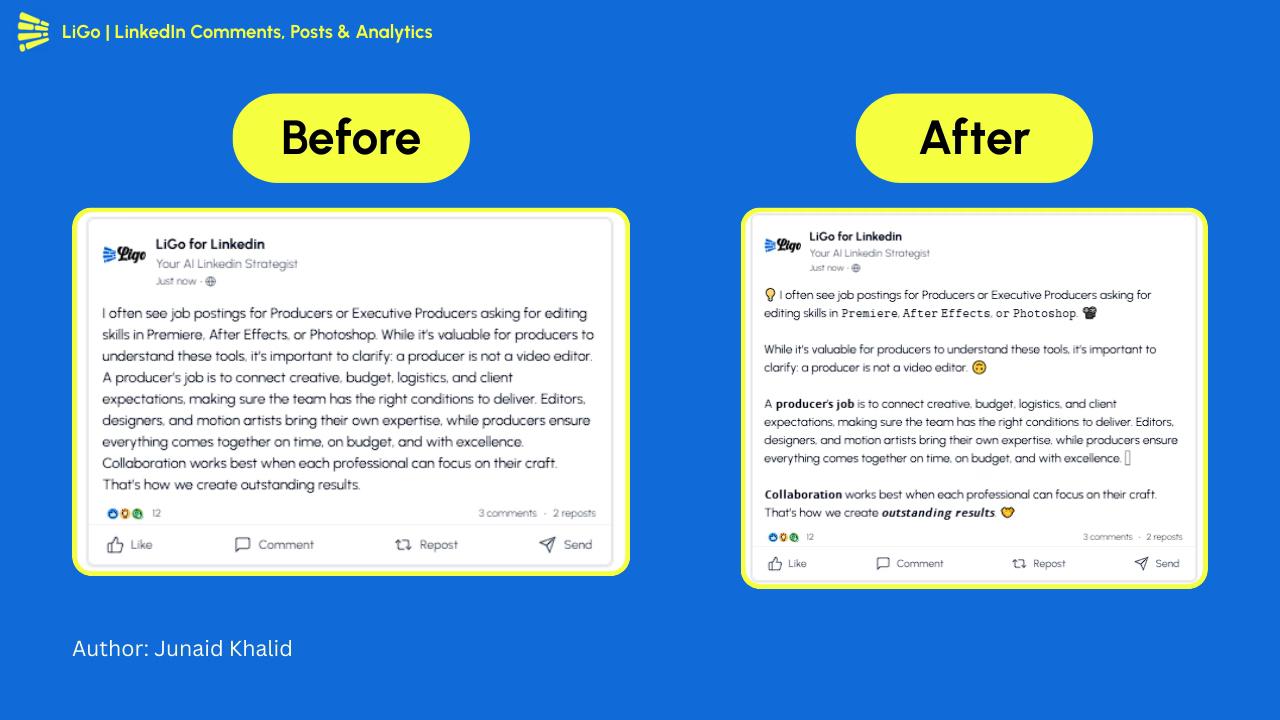"When's the best time to post on LinkedIn?"
It's the question every professional asks-and most get a frustratingly generic answer.
The truth is, there is no universal "best day to post on LinkedIn" that works for everyone. What works for a software developer in San Francisco might fail completely for a financial advisor in New York.
After analyzing millions of LinkedIn posts across different industries, I've found that optimal posting times vary dramatically based on:
-
Your specific industry
-
Your audience's job functions
-
Geographic distribution of your network
-
The type of content you're sharing
Let's break down what the data actually shows about the best time to post on LinkedIn for YOUR specific situation.
The Science Behind LinkedIn Posting Times
First, let's understand how LinkedIn's algorithm actually handles post distribution:
-
Initial Testing: When you publish, LinkedIn shows your post to approximately 10% of your connections
-
Engagement Evaluation: The algorithm measures how quickly this sample audience engages
-
Broader Distribution: Posts that generate quick engagement get distributed more widely
-
Continued Assessment: This cycle repeats several times in the first few hours
This means the ideal posting time needs to align with when YOUR specific audience is:
-
Actively checking LinkedIn
-
In a mindset to engage (not just scroll)
-
Not overwhelmed with competing content
Industry-Specific Best Days to Post on LinkedIn
Our analysis reveals significant variation across different professional sectors:
Technology & Software
Best days to post: Tuesday, Wednesday, Thursday
Best times: 9-10:30 AM, 1-2:30 PM local time
Worst times: Before 8 AM, after 5 PM, weekends
Why it works: Tech professionals typically check LinkedIn during morning setup and afternoon breaks, using it as a professional break from project work.
Finance & Professional Services
Best days to post: Monday, Tuesday, Wednesday
Best times: 7-8:30 AM, 5-6:30 PM local time
Worst times: Mid-day (when client meetings typically occur)
Why it works: Finance professionals often check LinkedIn before and after market hours or client meetings.
Creative Industries & Marketing
Best days to post: Tuesday, Thursday
Best times: 10-11:30 AM, 7-9 PM local time
Worst times: Early morning, Monday morning
Why it works: Creative professionals tend to start their day with production work and check social platforms later in the morning or after work hours.
Productie & Industrieel
Best days to post: Tuesday, Wednesday, Thursday
Best times: 7-8 AM, 3-4 PM local time
Worst times: Mid-morning (production peak times)
Why it works: Manufacturing leadership often checks communications before shift start and during afternoon administrative time.
Healthcare
Best days to post: Monday, Wednesday
Best times: 11 AM-1 PM, 7-9 PM local time
Worst times: Morning hours (rounds and patient care)
Why it works: Healthcare professionals typically check social media during lunch breaks or after shifts.
Content Type Affects Optimal Posting Time
Interestingly, the type of content you're sharing should influence when you post:
Thought Leadership/Industry Analysis
Best days: Tuesday, Wednesday morning
Waarom : Professionals are mentally fresh and receptive to industry insights early in the week
How-To/Educational Content
Best days: Thursday, Friday
Waarom : Professionals are looking for implementation ideas as they plan the following week
Company News/Announcements
Best days: Monday, Tuesday
Waarom : Attention to organizational updates is highest at the week's start
Career Development/Inspirational
Best days: Sunday evening, Wednesday afternoon
Waarom : Career reflection happens during Sunday planning and mid-week evaluation
This means your content calendar should consider both your industry AND your content type when determining the best time to post on LinkedIn.
The Data Behind Optimal Posting Times
Let's look at some specific numbers from our analysis of engagement patterns:
| Industry | Top Performing Day | Average Engagement Increase |
|---|---|---|
| Technology | Dinsdag | +37% over average day |
| Finance | Maandag | +42% over average day |
| Marketing | Donderdag | +29% over average day |
| Healthcare | Woensdag | +23% over average day |
| Manufacturing | Dinsdag | +31% over average day |
Even more revealing is how posting time affects specific engagement metrics:
| Posting Time | Opmerkingen | Shares | Profile Visits |
|---|---|---|---|
| Early Morning (7-8 AM) | +12% | -4% | +8% |
| Mid-Morning (9-11 AM) | +27% | +31% | +18% |
| Lunch (12-1 PM) | +15% | +22% | +7% |
| Afternoon (2-4 PM) | +8% | +17% | +23% |
| Evening (6-8 PM) | -7% | +4% | +41% |
This data suggests different posting times optimize for different goals. Morning posts drive more comments and shares, while evening posts drive more profile visits-potentially indicating deeper interest from viewers with more time to explore.
Beyond Generic Advice: Finding YOUR Best Posting Time
While industry benchmarks provide a starting point, your specific audience might have unique patterns. This is exactly why most LinkedIn "best time to post" advice is wrong - generic recommendations don't account for your specific audience's behavior. Here's how to find the best time to post on LinkedIn for YOUR network:
Method 1: A/B Testing Approach
-
Create similar posts (same topic, format, and length)
-
Post op verschillende tijdstippen gedurende de week
-
Track engagement metrics for each time slot
-
After 3-4 weeks, analyze which times consistently perform best
Method 2: Use a LinkedIn Analytics Tool
A dedicated tool like LiGo's LinkedIn analytics dashboard can automatically:
-
Analyze when your specific audience is most active
-
Track which time slots generate the most meaningful engagement
-
Identify performance patterns based on content type
-
Recommend optimal posting windows for your unique audience
The data from LiGo's analysis of thousands of profiles shows that personalized posting times outperform industry averages by 31-47%, highlighting the importance of audience-specific timing.
Time Zone Considerations for Global Audiences
If your audience spans multiple time zones, posting time becomes even more complex. Here are two effective strategies:
Strategy 1: Target Your Primary Audience
Identify where the majority of your ideal clients/connections are located and optimize for their time zone.
Strategy 2: Use the "Global Peak" Windows
Certain time slots perform reasonably well across multiple time zones:
-
8 AM EST (aligns with East Coast morning, European afternoon, and Asian evening)
-
1 PM EST (catches West Coast morning, East Coast afternoon, and European evening)
For those with truly global audiences, scheduling tools become essential for posting at optimal times across different regions.
The Algorithm Factor: LinkedIn's Hidden Timing Preferences
Beyond audience activity, LinkedIn's algorithm itself appears to have timing preferences:
-
Weekday Priority: Posts published Monday-Friday receive 18-27% more initial distribution than weekend posts
-
Business Hours Boost: Content published during standard business hours (8 AM-5 PM) receives preferential initial distribution
-
Consistency Rewards: Accounts that post at similar times each week receive algorithm favor
This suggests that the best posting time combines both audience activity patterns AND algorithm preferences.
The Consistency Factor (It Might Matter More Than Perfect Timing)
While finding optimal posting times matters, our data reveals something even more important: consistency outweighs perfect timing.
Accounts posting consistently (same days/times each week) see 78% higher average engagement than those posting at theoretically "optimal" times but with irregular schedules.
This is because:
-
Your audience learns when to expect your content
-
The algorithm better understands when to distribute your posts
-
You build a habit that ensures regular posting
A LinkedIn scheduling tool is invaluable here, allowing you to maintain consistency without being tied to your device at specific times.
Real-World Case Study: Timing Optimization in Action
Let me share a quick example showing the impact of optimized posting times:
Klant : B2B Software Agentschap
Eerste benadering : Posting whenever content was ready (mostly afternoons)
Average Engagement: 17 interactions per post
After analyzing their audience with LiGo's LinkedIn analytics tool, we discovered their target audience of technical decision-makers was most active Tuesdays and Thursdays between 9:30-10:30 AM.
Nieuwe aanpak : Scheduling posts for these specific windows
Results After 30 Days:
-
Average engagement increased to 42 interactions per post (+147%)
-
Comment rate improved by 218%
-
Profile visits from posts rose by 173%
The content itself didn't change-only the posting time. This highlights how significant timing optimization can be when done correctly.
The Posting Time Strategy That Actually Works
Based on all this data, here's the most effective approach to LinkedIn posting times:
-
Start with industry benchmarks from this article
-
Refine based on your specific audience using analytics tools
-
Create a consistent posting schedule around these optimal times
-
Use a LinkedIn scheduling toolom consistentie te behouden
-
Test and adjust quarterly as audience patterns evolve
This balanced approach leverages data while acknowledging that your audience may have unique characteristics.
Common Posting Time Mistakes to Avoid
As you optimize your posting schedule, watch for these common pitfalls:
1. The Rush Hour Problem
Posting exactly when studies recommend means competing with thousands of others following the same advice. Consider posting 15-30 minutes before peak times for better visibility.
2. The Set-and-Forget Mistake
Audience patterns change over time. What worked six months ago might not work today. Regular analysis and adjustment are essential.
3. The Content Mismatch Error
Different content types perform differently at various times. A complex thought leadership piece might fail in a time slot where quick tips thrive.
4. The Inconsistency Trap
Posting at optimal times but with irregular frequency confuses both your audience and LinkedIn's algorithm.
Leveraging Tools for Perfect Timing
The most efficient way to implement these strategies is through purpose-built tools:
LinkedIn Scheduling Tools
Schedule posts for optimal times without being at your device when it's time to publish.
LinkedIn Analytics Platforms
Track performance across different time slots to identify your specific patterns.
Content Calendar Systems
Plan diverse content types aligned with ideal posting windows.
LiGo combines all these features, allowing you to generate content, schedule for optimal times, and track performance-all within one integrated platform.
De bottom line op LinkedIn Posting Times
Finding the best time to post on LinkedIn isn't about following generic advice-it's about understanding your specific audience and content through careful analysis.
While industry benchmarks provide a starting point, the highest-performing LinkedIn users:
-
Analyze their unique audience patterns
-
Maintain consistent posting schedules
-
Use data to refine their approach over time
-
Leverage tools to implement their strategy efficiently
Remember: The perfect posting time amplifies good content but won't save poor content. Focus first on creating value, then optimize timing to ensure that value reaches your audience when they're most receptive.
Here's a few snapshots from LiGo for LinkedIn's Analytics Dashboard to paint a picture for you before you try yourself:
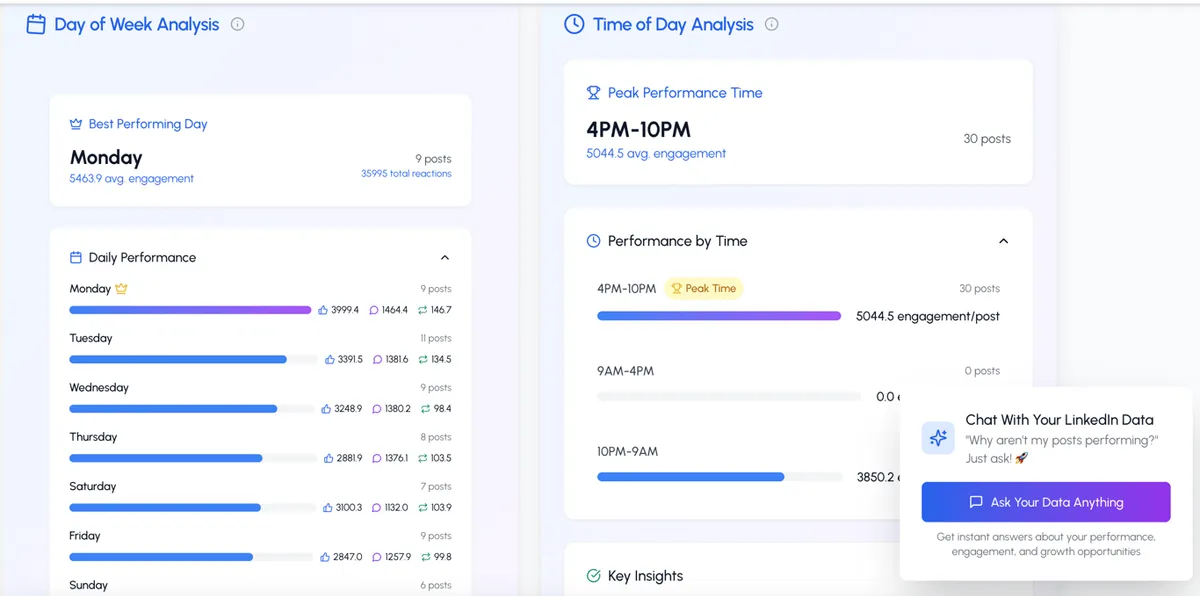
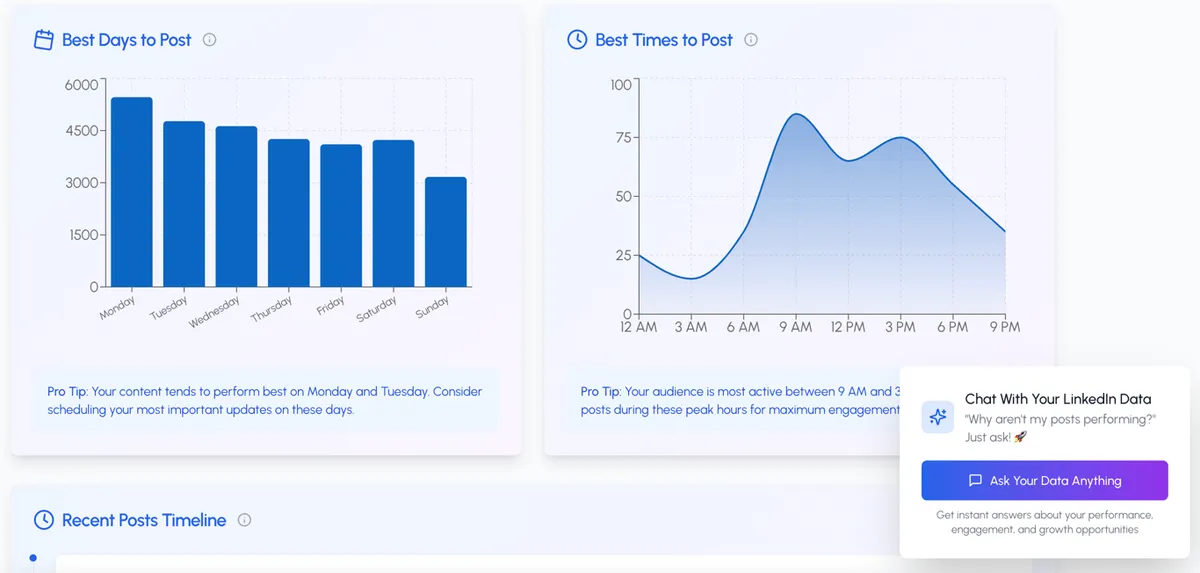
Wil je meer LinkedIn-strategieën?
Bekijk deze gerelateerde artikelen:


